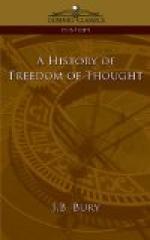[88] at Rome, Galileo went thither, confident that he would be able to convince the ecclesiastical authorities of the manifest truth of Copernicanism. He did not realize what theology was capable of. In February 1616 the Holy Office decided that the Copernican system was in itself absurd, and, in respect of Scripture, heretical. Cardinal Bellarmin, by the Pope’s direction, summoned Galileo and officially admonished him to abandon his opinion and cease to teach it, otherwise the Inquisition would proceed against him. Galileo promised to obey. The book of Copernicus was placed on the Index. It has been remarked that Galileo’s book on Solar Spots contains no mention of Scripture, and thus the Holy Office, in its decree which related to that book, passed judgment on a scientific, not a theological, question.
Galileo was silenced for a while, but it was impossible for him to be mute for ever. Under a new Pope (Urban VIII) he looked for greater liberty, and there were many in the Papal circle who were well disposed to him. He hoped to avoid difficulties by the device of placing the arguments for the old and the new theories side by side, and pretending not to judge between them. He wrote a treatise on the two systems (the Ptolemaic and the Copernican) in the form
[89] of Dialogues, of which the preface declares that the purpose is to explain the pros and cons of the two views. But the spirit of the work is Copernican. He received permission, quite definite as he thought, from Father Riccardi (master of the Sacred Palace) to print it, and it appeared in 1632. The Pope however disapproved of it, the book was examined by a commission, and Galileo was summoned before the Inquisition. He was old and ill, and the humiliations which he had to endure are a painful story. He would probably have been more severely treated, if one of the members of the tribunal had not been a man of scientific training (Macolano, a Dominican), who was able to appreciate his ability. Under examination, Galileo denied that he had upheld the motion of the earth in the Dialogues, and asserted that he had shown the reasons of Copernicus to be inconclusive. This defence was in accordance with the statement in his preface, but contradicted his deepest conviction. In struggling with such a tribunal, it was the only line which a man who was not a hero could take. At a later session, he forced himself ignominiously to confess that some of the arguments on the Copernican side had been put too strongly and to declare himself ready to confute the




